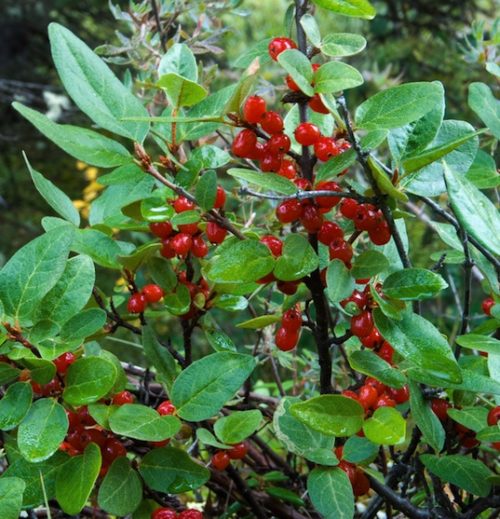
Shepherdia were an important Native American and First People’s food.
There are only three species in the genus Shepherdia, all in North America, and one brings up a good point. When you go up in elevation you often go north in flora and fauna. There are some northern plants that grow south on the tops of Appalachian Mountains but no where else at lower elevations in the south. Two of the Shepherdia species grow mostly in northern states. But, one is in Utah and Arizona on the Colorado Plateau… which is 5,000 to 7000 feet. The plant thinks it’s further north than it really is.
Some three dozen native groups depended on the species and with good reason. A hundred grams of Shepherdia canadensis has 80 calories, 0.7 grams of protein, 0.7 grams of fat, 16.6 grams of carbohydrates, and 5.3 grams of fiber. Vitamin C is outstanding and about three times your daily need, at 165.6 mg. Vitamin A in a separate report said it was 0.97 grams. The B vitamins are B1 (thiamin) 0.03 mg, B2 (riboflavin) 0.1 mg B3 (niacin) 0. 2 mg. Phosphorus is 21 mg, calcium 16 mg, magnesium 8 mg, zinc 1.4 mg, iron and sodium, o.5 mg each, 0.2 mg manganese, 200 mcg copper and strontium 70 mcg.
These berries get around. S. aragentea is in the western two-thirds of North America excluding Texas to Maine and southeast. Oddly it’s in one eastern country of New York, an escapee perhaps. Of all the west it is not reported in Washington state. S. canadensis is in all of Canada, the western third of the U.S. and the states north and east of Illinois. It’s in Vermont were I still have cousins living and didn’t quite get down to where I lived in Maine. Roundleaf Buffaloberry is found in southern Utah and northern Arizona.
Argentea is new Dead Latin for silvery. Canadensis of or from Canada. Rotundifolia means round leaf. The genus is named for John Shepherd, 1764-1836, curator at the Liverpool Botanic Garden.
IDENTIFICATION:
Shepherida argentea: Deciduous shrub to small tree 20 feet tall, (20 ft) dense silvery surface on the bottom of leaves and young twigs. Older branches commonly tipped with a spine, leaves wedge-oblong, no teeth. Flowers small, inconspicuous, in clusters in the leaf axils, fruits are scarlet. Also called Silver Buffaloberry, it’s high in pectin.
Shepherdia canadensis: Soapberry. Deciduous shrub under six feet, oval to lance-shaped leaves, smooth edges. Bottom of leaves and twigs covered with rust-colored surface, flowers small, green, inconspicuous, bloom in early spring, berries single or in clusters in leaf axils, orange to deep red, covered with small dots. It also has a small amount of saponins so it can make a foam. Also called Buffaloberry it pairs well with Blackberries.
Shepherdia rotundifolia: Roundleaf Buffaloberry: Unlike its relatives the S. rotundifolia is evergreen, has tightly packed silvery leaves, wooly below, and scruffy rough berries.
TIME OF YEAR: Shepherdia canadensis: Bitter berries in July to early August. Shepherdia argentea: Tart berries in in fall usually after a frost. Shepherdia rotundifolia fruits in late summer.
ENVIRONMENT: Open woods, thickets, rocks, shores. The species is a nitrogen-fixer.
METHOD OF PREPARATION: Eaten raw, cooked or dried. Can be made into a juice, jam, jelly or used as a flavoring. Natives also dried, smoked and pressed into cakes. They were also whipped until they created a foam then sugar was added for something akin to whipped cream.

